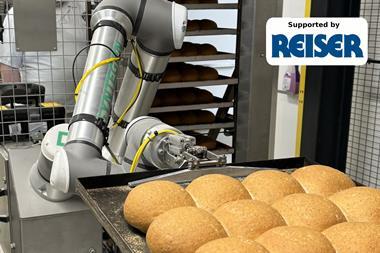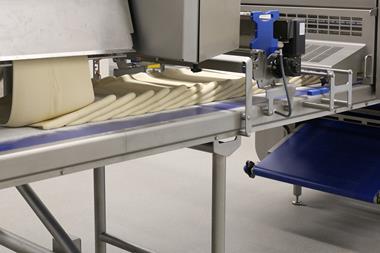Trends for artisan breads, gluten-free products and wetter doughs are challenging equipment suppliers to keep pace and offer kit that will fit the bill
Demand for mass-production of artisanal-style products, including sourdoughs, rye breads and seeded loaves, means dividers and moulders are being tested more than ever.
Wet dough, soft dough, dough with additions, dough that has been proved for 12 hours rather than four, all require different handling than standard bread dough.
As a result, Mono Equipment has seen a real shift in how bakers are using their kit, and has developed new equipment to cope with doughs containing far more water, as well as a variety of ingredients.
“With a traditional bread divider, the dough would just get stuck in the rollers,” says Mono sales director Chris Huish. “We’ve definitely seen a change in demand.”
Among Mono’s NPD is an automatic divider moulder called Paneotrad Mark 2, which Huish describes as perfect for soft doughs such as sourdoughs: “It preserves the open texture of the dough and can produce large products such as 60cm baguettes.”
For smaller bakeries, Mono has designed a more petite version that offers similar functions. Called the Paniform, it can produce a 30cm baguette and many other shaped products. “It has a built-in flour duster, it uses gentle pressure, and can handle doughs with 75-80% water content without losing texture while it cuts it into sections,” says Huish.
Other launches this year include Koenig dough dividing and rounding machine Mini Rex Multi, which has an hourly capacity of 4,800 pieces and can produce rounded and rustic products. The variety can be expanded with an additional forming station and seeder.
Other equipment, such as the Vemag dough divider, available through Reiser UK, has been designed to handle different consistencies, from stiff bagel dough to soft English muffin dough.
The decision to invest in a new divider or moulder isn’t only about the range of breads they can work with. Family business Modern Baking Systems supplies bakeries with new and used equipment. Barry Smith, a director, says investing in new equipment is becoming more attractive because of concerns about staff bills.
“More bakers are using dividers if they’re increasing production because of the cost of labour and the ability to be able to produce much higher quantities with much more accuracy,” he explains.
This could be down to rises in the minimum wage, and also because of concerns about filling roles after Brexit.
“Even if you’re spending £10-20,000, it’s still a worthwhile investment due to the amount of time you will save and the ability for bakers to use their labour more efficiently in other areas of the business,” he says. “The product will be much more accurate and can still be moulded by hand.”
Smith says there has been a shift in demand for the type of divider bakers are buying for a number of reasons. “We’re seeing a move towards hydraulic dividers and more people looking to avoid dividers that use oil to lubricate moving parts such as rams and pistons,” he says. “A high-quality oil can cost £2 to £3 per litre, so the cost soon adds up. Oil dividers also produce some mess, which makes cleaning more unpleasant and time-consuming.”
Speciality breads are also better when produced with this type of machine, he notes. “Hydraulic volumetric dividers are better at handling soft dough and, instead of a ram filling a chamber, it sucks down the dough, turns the head and places the dough on the outfeed belt. So it’s a lot gentler and doesn’t knock the air out of the product,” says Smith.
Hydraulic machines are also able to handle slightly wetter doughs, making them well placed to tap current trends.
Case Study:
Lewis Freeman, Dunn’s Bakery, Crouch End, north London
What dividers and moulders do you use? We use a Merand hydraulic divider that is about 11 years old. It cuts around 20 pieces at a time. We also have a moulder that dates back from the 1950s from when my grandfather was running the business. It was made by Job’s Electricals, which no longer exists, in the east end of London. We had it completely rebuilt recently due to wear and tear by Becketts Food Equipment, in order to extend its life even further.
How do you use them? We use the moulder for London bloomers and tin bread. You can hand-feed it or use a small plant and it does around 15 a minute. It’s no good for anything soft; ciabatta dough would get stuck in the rollers, so we do those by hand. We use the divider just to cut up the dough.
Does the equipment suit your current needs and are you looking to change your kit in the coming years? What we have suits our needs. We are happy to make lots of products by hand, so we’re not worried about having something for soft dough. I have seen a checkweigher and divider that costs £200,000 but we’re not really in the market for that, so I think we’ll just stick to the dough knife for now.
Case study:
John Gall, Brownings the Bakers, Kilmarnock
What dividers and moulders do you use? We use a Scobie McIntosh hydraulic divider, an Oddy roll plant divider moulder and a Koenig moulder.
How do you use them? The Scobie McIntosh is used to produce scones 95% of the time, and it can make 1,000 an hour. We use the Oddy and Koenig for breads and they can handle any type of dough, so as we’ve changed products over the years and trends have changed, they’ve been capable of anything.
Does the equipment suit your current needs and are you looking to change your kit in the coming years? They’re fine at the moment. I go to trade shows and look at what’s new on the market and I might upgrade at some point over the next few years. But, at the moment, the machinery I’ve got is fairly up to date, so until they bring out something really different I’m happy with what I have.














































No comments yet